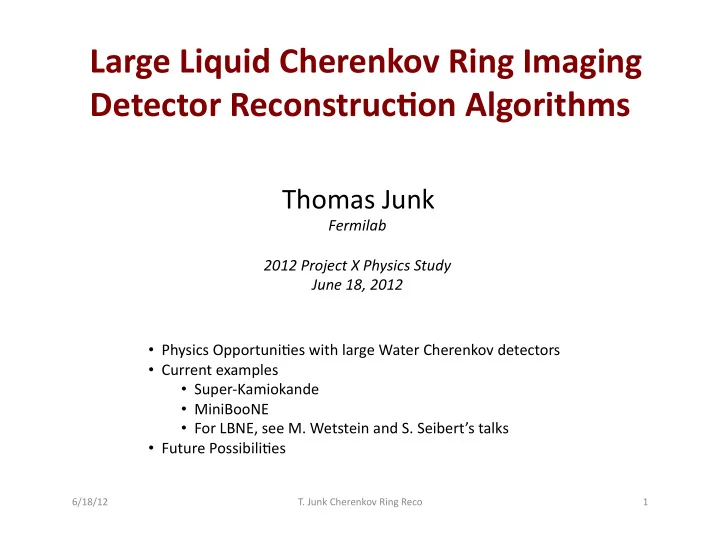

Large Liquid Cherenkov Ring Imaging Detector Reconstruc8on Algorithms Thomas Junk Fermilab 2012 Project X Physics Study June 18, 2012 • Physics Opportuni?es with large Water Cherenkov detectors • Current examples • Super‐Kamiokande • MiniBooNE • For LBNE, see M. Wetstein and S. Seibert’s talks • Future Possibili?es 6/18/12 T. Junk Cherenkov Ring Reco 1
Physics Opportuni8es with Large Water‐Cherenkov Detectors • Neutrino Oscilla?on Measurements • sin 2 (2θ 13 ) ‐‐ it’s already measured by Daya Bay, RENO, T2K, Double Chooz Cri?cally depends and others, but addi?onal precision and on ability to consistency tests are valuable (new physics) measure ν e appearance • Mass Hierarchy in a predominantly • Measurement of δ CP ν μ beam • Non‐Standard Interac?ons • Atmospheric Neutrino Oscilla?on Measurements • Supernova Burst Neutrinos • Relic Supernova Neutrinos • Nucleon Decay • Neutron‐An?neutron Oscilla?ons 6/18/12 T. Junk Cherenkov Ring Reco 2
The Super‐Kamiokande Detector Located 1 KM underground. 50 kTons of water; 11,129 50‐cm PMT’s facing inwards 40% photocathode coverage 1,885 20‐cm PMT’s facing outwards (veto) 6/18/12 T. Junk Cherenkov Ring Reco 3
Sample T2K Events in Super‐Kamiokande IV From the T2K NIM ar?cle: K. Abe et al., NIM A 659 , 106 (2011) arXiv:1106.1238v2 6/18/12 T. Junk Cherenkov Ring Reco 4
Typical Events in Super‐Kamiokande Mul?‐ring event. Throughgoing Cosmic Ray Almost a proton decay candidate, failed some analysis cuts. Found by Bref Viren. 6/18/12 T. Junk Cherenkov Ring Reco 5
SK Reconstruc8on Overview References: • M. Shiozawa, “Reconstruc?on algorithms in the Super‐Kamiokande large water Cherenkov detector”, NIM A 433 , 240 (1999). • SK Collabora?on, “A measurement of atmospheric neutrino oscilla?on parameters by SK‐1”, Phys Rev. D 71 , 112005 (2005). • SK Collabora?on, “Kinema?c reconstruc?on of atmospheric neutrino events in a large water Cherenkov detector with proton iden?fica?on” PRD 79 , 112010 (2009). • T2K Collabora?on, “The T2K Experiment”, NIM A 659 , 106 (2011). • See also Kimihiro Okumura’s talk at ANT11 on POLFIT op?miza?on for reduc?on of π 0 background. hfps://indico.fnal.gov/conferenceDisplay.py?confid=4887 Reconstruc8on Steps: All reconstruc?on amounts to maximizing 1) Vertex fit L(data|event parameters) 2) Ring iden?fica?on (Hough Transform) 3) Par?cle ID Algorithms are designed to factorize the problem 4) Mul?‐Ring Separa?on in pieces that can be 5) Momentum Determina?on solved reliably. 6/18/12 T. Junk Cherenkov Ring Reco 6
SK Vertex Fit i indexes the hit PMT σ i is the ?ming resolu?on of the i th PMT <σ> is the average resolu?on over the hit PMT’s t’ i is the TOF‐subtracted ?me, including the track length G is a likelihood func?on and t 0 is chosen to maximize it Resolu?on (1999, MC): 18 cm for p e + π 0 . 34 cm for single‐ring electron events 25 cm for single‐ring muon events M. Shiozawa, NIM A 433 , 240 (1999). 6/18/12 T. Junk Cherenkov Ring Reco 7
Ring Finding – Hough Transform Atmospheric neutrino single‐ring efficiency (1999) These days, count rings with the Hough transform, and check with a likelihood func?on 6/18/12 T. Junk Cherenkov Ring Reco 8
Par8cle ID Comparison of observed pafer of light with that expected for an electron‐like or muon‐like ring. Slide taken from K. Okumura ANT11 6/18/12 T. Junk Cherenkov Ring Reco 9
Slide taken from K. Okumura ANT11 6/18/12 T. Junk Cherenkov Ring Reco 10
Slide taken from K. Okumura ANT11 6/18/12 T. Junk Cherenkov Ring Reco 11
Par8cle ID Likelihood Separa8on – e vs μ Single Ring Events Mul?‐Ring Events Sub‐GeV Sub‐GeV Mul?‐GeV Mul?‐GeV PRD 71 112005 6/18/12 T. Junk Cherenkov Ring Reco 12
POLfit – e vs. π 0 Separa?on Algorithm Slide taken from K. Okumura ANT11 6/18/12 T. Junk Cherenkov Ring Reco 13
Slide taken from K. Okumura ANT11 6/18/12 T. Junk Cherenkov Ring Reco 14
Slide taken from K. Okumura ANT11 6/18/12 T. Junk Cherenkov Ring Reco 15
Calibra?on of e‐π 0 Separa?on Algorithm Slides taken from K. Okumura ANT11 6/18/12 T. Junk Cherenkov Ring Reco 16
Achieved Performance of Super Kamiokande Reconstruc8on • Vertex resolu?on: 18 cm for p e + π 0 . 34 cm for single‐ring electron events 25 cm for single‐ring muon events • Angular resolu?on: 3° (electron‐like rings), 1.8° (muon‐like rings) • CC QE efficiency: 93% (electron, single ring) 96% (muon, single ring) • Energy resolu?on for single rings • muons: ± (0.7/sqrt(E(GeV))+1.7)% electrons: ±(2.6/sqrt(E(GeV)) + 0.6)% • • Background rejec?on: < 0.1% muons misID’ed as electrons , < 5% NC π 0 ’s misID’ed as electrons (From M. Shiozawa’s talk on Saturday 6/18/12 T. Junk Cherenkov Ring Reco 17
MiniBooNE Experiment 6.1m radius sphere filled with minearal oil. 1280 inward‐ facing 8” PMT’s (5.75 m radius inner region) 240 outer PMT’s for veto Direct and scafered Cherenkov light, plus scin?lla?on light with a life?me of 35 ns. R. Paferson et al. , “The Extended‐track Reconstruc?on for MiniBooNE”, NIM A 608 , 206 (2009). 6/18/12 T. Junk Cherenkov Ring Reco 18
Slide from M. Tzanov 6/18/12 T. Junk Cherenkov Ring Reco 19
Slide from M. Tzanov 6/18/12 T. Junk Cherenkov Ring Reco 20
Similari8es and Differences between SK and MiniBooNE Reconstruc8on • MiniBooNE: Scin?lla?on light significant and included in likelihood. SK: no scin?lla?on • MiniBooNE: Spherical detector geometry simplifies likelihood func?on lookup tables SK: Cylindrical geometry more complicated • MiniBooNE: Include PMT’s that are not hit in the likelihood func?on as well as hit PMT’s. Adds informa?on. For larger detectors, there are more unhit PMT’s. But computers always get more capacity. • Similar strategies for tes?ng single, double, and mul?ple‐ring hypotheses 6/18/12 T. Junk Cherenkov Ring Reco 21
Achieved Performance of MiniBooNE Reconstruc8on • CC QE ν μ events: 10 cm vertex resolu?on, 8% energy resolu?on 2° angular resolu?on • CC QE ν e events: 20 cm vertex resolu?on, 12% energy resolu?on • ν μ misiden?fica?on rate as ν e ~2% for 65% efficiency 6/18/12 T. Junk Cherenkov Ring Reco 22
Electron – Pizero Separa8on in MiniBooNE 6/18/12 T. Junk Cherenkov Ring Reco 23
Recommend
More recommend